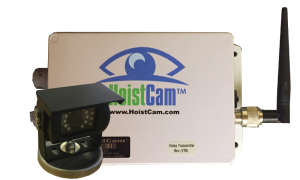Troubleshooting Common Issues in the Hoist Cam Wireless Camera System for Cranes
In crane operations, visibility equals safety. When your operator can’t see the load, blind spots, or surroundings clearly, the risk goes up.

That’s where the Hoist Cam Wireless Camera System for Cranes comes in. It gives real-time visuals of the hook, boom, and crew—all from a safe distance. But like any tech, even the most advanced camera systems can run into issues.
This guide walks through the most common problems users face and how to fix them quickly. Whether you're using it alone or alongside the SIG-LITE Power Line Proximity Warning System, keeping your camera system functional is key to maintaining safe, efficient lifting operations.
1. No Signal or Video Feed
One of the most frequent problems is a blank or frozen screen. If your Hoist Cam Wireless Camera System for Cranes isn’t transmitting video, try the following steps:
-
Check the power on both the transmitter and monitor.
-
Inspect the antenna connections for any looseness or damage.
-
Make sure the system is paired—sometimes, a reset is all it takes.
-
Look for interference from other wireless devices or heavy machinery.
Wireless systems rely on clean line-of-sight communication. Large steel structures, power lines, or even other wireless systems like the SIG-LITE Power Line Proximity Warning System could potentially disrupt the signal if too close.
2. Battery Not Holding Charge
The camera unit is usually battery-powered. If it’s not lasting through your shift:
-
Replace the battery if it's old or damaged.
-
Check the charger and cable—a faulty charger can trick you into thinking the battery is dead.
-
Make sure it’s being turned off when not in use to save power.
Some users mistakenly leave the camera on between lifts, draining the battery faster than expected.
3. Blurry or Unclear Video
If the image is fuzzy, your Hoist Cam Wireless Camera System for Cranes isn’t doing its job.
-
Clean the camera lens—dirt, grease, or even morning condensation can reduce clarity.
-
Check the camera focus setting if it has manual adjustment.
-
Look at screen settings like contrast and brightness. These can throw off your image quality, too.
In some cases, mounting the camera too far from the target area can also reduce the detail seen on the monitor.
4. Camera Doesn’t Power On
This might seem obvious, but it happens often.
-
Double-check that the battery is charged and inserted correctly.
-
Inspect wiring connections inside the casing if applicable.
-
Try powering it with another battery to rule out unit failure.
For systems used alongside the SIG-LITE Power Line Proximity Warning System, make sure that your power supply isn’t being shared improperly or overwhelmed by too many connected devices.
5. Intermittent Video Drops
If your camera works one moment and cuts out the next:
-
Watch for signal interference—metal structures or nearby radios could disrupt transmission.
-
Try repositioning the antenna for a better line of sight.
-
Ensure proper grounding if the camera is mounted on a crane part exposed to static or surge.
Environmental factors like weather or RF interference can have a temporary impact. If your site has multiple wireless safety tools (such as the SIG-LITE Power Line Proximity Warning System), coordinate their frequencies with your supplier to avoid conflicts.
6. Mounting Problems
Even a well-functioning camera is useless if it’s not pointed at the right spot.
-
Use magnetic or clamp mounts approved for crane applications.
-
Secure cables and mounts properly to prevent vibration damage.
-
Make adjustments slowly and test alignment with test lifts.
Mounting failures are usually caused by improper installations or trying to “make do” with poor hardware. Always follow manufacturer guidelines.
General Maintenance Tips
To prevent these issues in the future:
-
Perform weekly system checks.
-
Inspect all connectors before each shift.
-
Clean the lens and screen at the start and end of the day.
-
Replace components at the first sign of wear.
Pairing your Hoist Cam Wireless Camera System for Cranes with a trusted solution like the SIG-LITE Power Line Proximity Warning System creates a dual-layer safety net—but only if both systems are working as they should.
Final Thoughts
Your crane operator depends on visual input to make safe calls. Any downtime in your Hoist Cam Wireless Camera System for Cranes isn’t just a technical hiccup—it’s a safety hazard. Staying proactive with troubleshooting helps you avoid delays, unsafe lifts, and costly mistakes. Combine that vigilance with proximity warning tools like SIG-LITE Power Line Proximity Warning System, and you’re building a site-wide culture of safety.